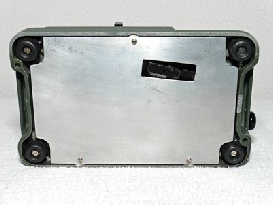






Details:
Although similar looking on the outside, the construction of the input register, a ratchet wheel, is totally different from the widely used pinwheel. This ratchet wheel construction has a big advantage: for both adding and subtracting the input register is turned in the same direction. This allowed the designers to automate division in a very early stage of calculator development (1925).
The red/white caps of this machine are not the original ones, nor is the bottom and the rubber feet.
Usage:
Addition/subtraction/multiplication:
As usual for this type of machine
Division:
Clear all registers. Put the mode selector in the upper left of the machine in the position marked with a white “:”. Move the carriage all the way to the right and press the “X<-->:” selector at the bottom of the carriage. The red line with the “-” sign should now point at the “8” on the base plate.
Enter the dividend in the positions 13 to 8 of the result register. Enter the divisor in the main register. Start turning the main shaft. The machine now starts subtracting until an underflow occurs. It then makes a small step, adds the divisor to correct the underflow, makes another small step and starts subtracting again. It continues until the carriage has reached its extreme left position. The quotient is in the counter register (left), the remainder is in the result register (right).
Note: If a machine works well, it runs very smoothly, also when underflow occurs and a step is made.
Function of some keys, switches etc
- Top-left switch: Determines whether the counter adds or subtracts
- Bottom-right switch: Determines whether the result register adds or subtracts
- Little switch on the main-register reset handle: Determines whether or not the main register is cleared after each turn
- Back-right switch: If pushed backward during main register reset, a yellow flag appears on the left. When next the result register is cleared, the result is transferred to the main register.



Click to view a full size picture (opens in a new tab)


Serial number:
Built in:
Functions:
Rotation speed:
Market-introduction:
Production until:
Price:
45 575
Ca. 1955/1956
Addition, Subtraction, Manual Multiplication, Automatic Division
1953
Ca. 1959 (Serial numbers range from 40 001 to probably 54 000: (See: bluemich.net/rechner/)
DM 665,- in 1956 (Source: See assets: Price list )
| Mechanical Calculators |
| Electronic Calculators |
| Typewriters |




